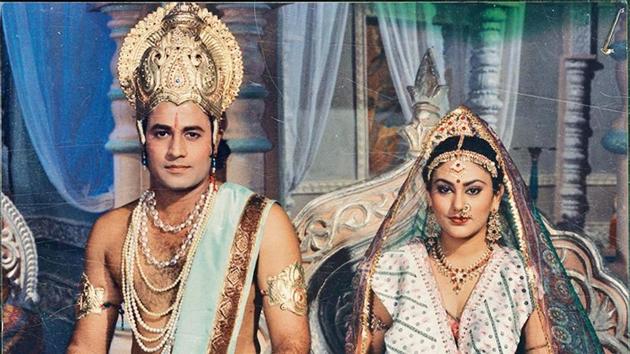Epics that inspired de facto ‘janta curfews’ three decades ago return in time of Covid-19 lockdown
Once again, you can watch Ramayan and Mahabharat on DD. The streets outside will still be empty – though, it’s a different kind of lockdown, necessitated by the coronavirus disease (Covid-19) pandemic.
When Ramayan began airing on Doordarshan (DD) on a cold January morning in 1987, few people, including its enthusiastic creator, producer-director Ramanand Sagar, could have foreseen the staggering phenomenon it was to become in the coming months. And soon after its 78 episodes concluded, came the next epic TV blockbuster: filmmaker BR Chopra’s Mahabharat, which launched in October 1988. Both shows had a Sunday morning slot, a time when the country came to a standstill.

Streets would empty out, shops would shut, telephones would be taken off the hook, appointments cancelled and people who had to work on Sundays would mysteriously disappear for the duration of the shows. Cinemas were known to cancel their morning shows. It was almost like a voluntary lockdown.
Now, the wheel has turned full circle. Once again, you can watch Ramayan and Mahabharat on DD. The streets outside will still be empty – though, it’s a different kind of lockdown, necessitated by the coronavirus disease (Covid-19) pandemic.
When Ramayan and Mahabharat first aired, it was a pre-liberalised India. There was just one television channel: DD. But in the 1980s, a revolution was brewing in the corridors of Mandi House, home to the DD offices. Faced with the proliferation of VCRs and pirated videos, and also to make some money, DD decided to give out programming to independent players (mainly from the film industry) and rope in private sponsors and advertisers as well. India’s first home-grown soap, Hum Log, had already enjoyed a hugely popular run from 1984 to 1985, and was followed up by other hit shows, such as Buniyaad.
But Ramayan and Mahabharat were in another league altogether. Within months of its first telecast, Ramayan was earning more money for DD than any other show. Advertisers were desperate to get a coveted ad slot during the show. Eventually, the show was telecast in more than 50 countries and estimated to have a viewership of around 650 million. When Mahabharat was shown in the UK by the BBC, it attracted five million viewers in its afternoon slot.
In the case of Ramayan, Sagar essentially took on the mantle of a television-age narrator of the epic, following modestly in the footsteps of legendary narrators such as the great Tulsidas from the 16th century. He tapped into his audience’s devotion to the epic and its intimacy with storytelling traditions such as the Ramlilas, enacted in every neighbourhood during Dussehra-Diwali.
TV critics of the time pointed to the slow pace of the serial and to its less-than-sophisticated special effects, but they missed the point. Sagar was not offering his viewers a TV serial, he was offering a devotional experience. Placed firmly in the calendar art style, borrowing from the Ramlila tradition and with a solid history of mythological films behind it, Sagar’s Ramayan brought the gods literally into people’s living rooms every Sunday morning. Newspapers and magazines of the time recorded numerous instances of viewers sanctifying their TV sets by lighting incense sticks and generally behaving as if they were going to get an actual darshan of Ram and Sita. There were public viewings, too, where large gatherings of people would congregate, and offer flowers and prasad.
The actors who played the lead roles were greeted with reverence by people when they appeared in public – once again underlying the fact that during Ramlila performances, actors are often seen as embodiments of the gods they are portraying.
With the Mahabharat, though, the appeal was less overtly religious and more to do with its sweeping, dramatic story and a cast of towering characters. The style was once again calendar art, but what lifted the show were its powerful dialogues, written by the accomplished Hindi novelist, poet and film writer Rahi Masoom Raza. When Raza’s name was announced, there was opposition from certain quarters – why was a Muslim man writing the dialogues for a Hindu epic? An affronted Raza, who came from Ghazipur in Uttar Pradesh, and was a staunch upholder of India’s syncretic traditions, replied: “I am a son of the Ganga. Who would know the civilisation and culture of India better than I?” He introduced the concept of time as the narrator (“Main samay hoon”) and created words and phrases that are still in currency, such as “pitashri” and “matashree.”
The Ramayan casting was cleverly done, even when it came to characters other than Ram and Sita. For example, queen Kaikeyi was played by actress Padma Khanna who had often been the vamp in Hindi films, and Manthra by Lalita Pawar, who, too, had played scheming roles in her film career. Actor Dara Singh, known for his wrestling prowess and action films, was cast as Hanuman. The main stars, of course, went on to become national icons – mainly, the relatively unknown Arun Govil, who played Ram with his trademark smile.
Many of Mahabharat’s actors are still identified by their roles in the epic – such as Mukesh Khanna, who, with his declamatory style, played the grand old guardian of the Hastinapur throne, Bhishma.
When Ramayan finally ended on July 31, 1988, and Mahabharat on June 24, 1990, both epics acquired a new life. Cassettes, CDs and DVDs of the show sold continuously; today, you can buy both series in digital format.





